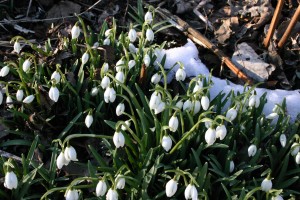Everyone at Wilderness Cottages would like to wish you a Happy New Year and we hope to welcome you as guests in 2014.
Don’t forget, its not too late to book a Winter break and we have some properties that are ideally located for skiers and climbers in what looks like could be another great winter season. Spring is a wonderful time to visit The Highlands and we have some excellent offers available at the moment.
This week, Ray’s contribution offers some good advice on planting your Christmas tree in your garden as well as the usual seasonal highlights…
 With the festive season that is now just over there were a number of plants and trees that are symbolic and probably the best example is the Christmas trees. At one time there was no choice over the type of conifer to use but now there are so many to choose from it can be bewildering. Some claim that the needles do not drop off whilst others pay more regard to the shape. When I recently looked at a few garden centres where they are sold it seems to me that more and more people are favouring the artificial trees. These again come in a bewildering variety with all manner of lighting systems and affects. A number of people buy trees with their roots still on so that they can eventually be planted out in the garden. From my own experience they need careful guidelines as to how to treat them before they go out in the garden. The other aspect to remember is just where you choose to plant them. What may look like a very attractive five feet tall tree will grow very high indeed and this must be planned for.
With the festive season that is now just over there were a number of plants and trees that are symbolic and probably the best example is the Christmas trees. At one time there was no choice over the type of conifer to use but now there are so many to choose from it can be bewildering. Some claim that the needles do not drop off whilst others pay more regard to the shape. When I recently looked at a few garden centres where they are sold it seems to me that more and more people are favouring the artificial trees. These again come in a bewildering variety with all manner of lighting systems and affects. A number of people buy trees with their roots still on so that they can eventually be planted out in the garden. From my own experience they need careful guidelines as to how to treat them before they go out in the garden. The other aspect to remember is just where you choose to plant them. What may look like a very attractive five feet tall tree will grow very high indeed and this must be planned for.
There are a few plants associated with that time of the year such as holly, ivy and mistletoe, with all of them associated with myths and legends some of which have long been forgotten. Perhaps the obvious one is holly that has diverse uses from decoration in their own right to part of wreaths. From a wildlife point of view in some areas with all the other berries such as hawthorn and rowans having been eaten the holly berries may be the only ones left for birds such as thrushes. The thrushes such as fieldfares and redwings have already been through and devastated what was, this year, an outstanding crop of rowan berries. It is left to other thrushes such as mistle thrush and blackbirds to seek out those berries that are left.
Mistletoe is another plant surrounded by myths and legends, and some garden centres will have had some for sale. However, this plant is not found in the Highlands although there is an old record for the Black Isle. Books say it can be propagated quite easily on to a variety of trees but I have tried this using berries to no avail. As for the ivy, people react differently to this plant, with some cutting them down from trees and buildings. In fact it is one of the most useful plants in winter giving shelter and nesting places for small birds.
At this time of the year many of us have thoughts that will turn to look for the first signs of spring. I do not have to look far because in one corner of the paddock, there are several clumps of snowdrops. Whatever the weather can throw at us, these will soon be pushing up their leaves and eventually their startling white flowers will appear. We may think that the snowdrop is native, but in fact they are an introduced plant. Their origin is in Europe where they are native to a number of countries. They were first brought to Britain in the 16th century and introduced into gardens and they were first found in the wild in the 18th century. The Latin name of the genus is galanthus, which means “milk white” whilst their specific name is nivalis, which means “snowy”. They often flower, as in the photograph, even when there is snow on the ground.
Tags: highland flora, highland wildlife
